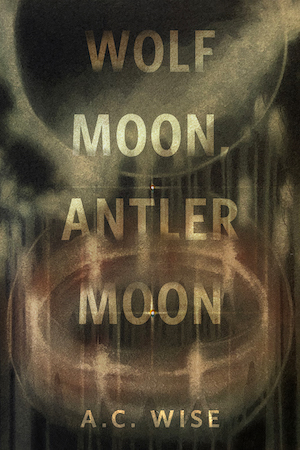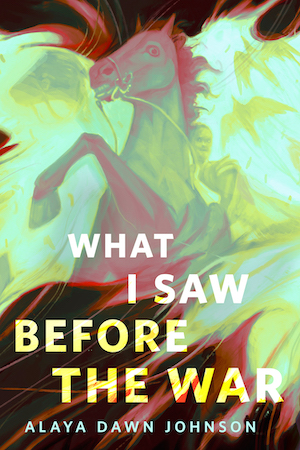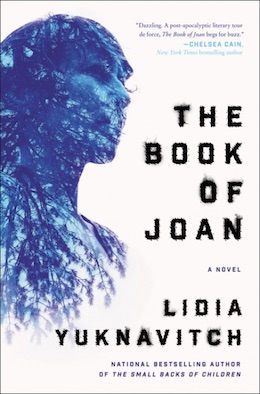Lidia Yuknavitch’s The Book of Joan is so much more than just a retelling of the story of Joan of Arc. Let’s get plot out of the way: In the near future, the Water Wars have ravaged the Earth. Those who are too young or weak to fight are crushed by a constant roving battle. One group gathers around Jean de Men, a charismatic but brutal leader who would exploit the planet’s resources until there is nothing left; the other around Joan of Dirt, a young woman warrior. Rather than hearing the voice of God, this Joan hears the voice of the Earth itself, a song that is being sung by the dirt, the trees, the water, the air…but this is no Disney ballad—it’s a song of fury and pain, and when it enters Joan’s mind it changes her life irrevocably.
From this ecologically-minded update of Joan of Arc Lidia Yuknavitch creates a masterful book that is concerned with the stories we tell ourselves, and how we choose to tell those stories. When humanity is at its endpoint, facing its ultimate destruction, what story will we whisper into the dark?
What is the central Western story?
A good man went against the state, was betrayed by a loved one, was tortured, died, came back to life, and didn’t seek vengeance. Whatever culture you personally belong to, whatever faith you have, or don’t have, or wish you had, wish you didn’t have—this is the story that fuels the West. It’s been used to torture, to inspire, to justify atrocity, to save lives. People have spent their entire lives writing supplementary stories, or counter stories. Sometimes the man takes revenge, sometimes he never existed, sometimes he lived a happy life with a family far away from the sacrifices his followers insist he made, sometimes he visited continents undreamed of by the characters in the original story. But that original story is the center, and everything else in our world, still, pivots around it.
The story of Joan of Arc works as a counterpoint. She went to war as a pacifist, never killed, was wounded but didn’t die, and didn’t seek revenge. She, too, was betrayed by a loved one, was tortured, and died. She did not come back—publicly tortured to death like her forebear, but without the transcendent epilogue. Revered for following God, she was told she had betrayed God.
At the center of Joan’s life is her death. Jesus was crucified, which is a very specific death. It takes days, and invites birds and insects to attack the victim. It is an utter destruction, especially if the corpse is left as an example to others, as the in the case of the bodies of Spartacus’ followers. Burning is quite different. Burning is quicker (not quick enough, one assumes, but still) less intimate in a way, since the onlookers have to keep back from the flame. While the victim’s body is being destroyed, it’s being converted into the energy of the fire, which is giving warmth to the audience. Rather than smelling of death it smells like cooking—a thing that humans are habituated to finding comforting. Fire is, after all, the first thing that separated us from beasts, even before writing.
Yuknavitch has taken burning and made it the center of her story, and has taken the two giant leaps of humanity and merged them. In Yuknavitch’s future, the elite of humanity have fled Earth for a space station called CIEL. In a somewhat mystical response to ecological horror, humans have rapidly devolved—becoming glowing white, hairless, genital-less creatures with no hope of breeding. The flight into space has proven only a brief reprieve from oblivion. In the sterile, rigidly authoritarian world of CIEL, a brutal new art has sprung up—“skinstories,” in which people use tiny welding torches to burn lines of poetry and art into their skin.
Our protagonist, Christine Pizan, is one of the skin artists; the ruler of CIEL, Jean de Men, is another. The two hate each other—Jean considers Christine’s work degenerate, and she has dedicated much of her career to lambasting his own works, which are often horrific rape fantasies inscribed in flesh. But Christine has a much more immediate reason to hate Jean: he led the army that executed Joan of Dirt, Earth’s last true general, as some of mankind fled the planet’s surface after a decade of war. In the book’s opening pages, we learn some of this history, and also that Jean has begun a new attack on Christine’s life-long best friend, Trinculo, an inventor who is considered an enemy of the state because of his queerness. This despite the fact that gender is fairly irrelevant now—but Trinc’s lack of respect for tradition is enough to earn Jean’s enmity.
Christine and her fellow CIELers invite the pain of burning because it’s one of the only sensations left to them. Their genitalia may have receded and smoothed into the dimensions of a Ken doll, but their minds still contain the same needs and desires they always did. One way to express the longing for physical sensation is this carefully controlled burning art, slightly more painful and intimate than tattooing. As people ran out of skin they began a secondary art of grafting new folds on and creating skin sculptures. Now true elites sweep curtains of skin behind them like bridal trains. Naturally Jean de Men has the most elaborate skin grafts of all. Naturally Christine burns Joan’s story into the most private parts of her body.
The Book of Joan author Lydia Yuknavitch practices a process she calls Corporeal Writing. The idea is that as you live you gain experience, and that everything you need to write is contained within your own body. She was a swimmer, she’s struggled with addiction. She’s given birth to a dead child, and to a living one. She has been physically abused, and physically joyful. This is all public knowledge—I’ve met Yuknavitch, briefly, but I don’t know her. This experience is in her book. When you read her work you are aware that you, too, are a body.
When you center a story in the body, particularly the female body, you’re going to have to grapple with ideas of autonomy, consent, life and death. We like the female body when it is wet, unless that wet is urine or period blood. We like the female body when it is DTF, not as much when it is Down To Eat or Down To Fight or, Ishtar save us, Down To Think. As the book twists and turns and changes shape it becomes far less the familiar story of a young girl leading a war, or becoming a nation’s sacrificial lamb, and becomes much more about women having control over what is done to their bodies. It also mediates long and hard on those people who want to assert their desire on other people, animals, or the Earth itself.
Yuknavitch uses sci-fi tropes as jumping-off points—like Jaroslav Kalfař’s Spaceman of Bohemia earlier this spring, The Book of Joan doesn’t bog itself down in discussing breathing apparatuses or window sealants. Yuknavitch is more interested in looking at how humanity reacts to their abrupt technological advances, and, even more so, to the effect the collapse of our ecosystem has on our collective sanity. (Spoiler alert: it’s not great!) She also uses a key moment from literary history in a fascinating way: the real-life Christine de Pisan, a poet who was one of the earliest recorded women to earn a living as a secular writer, critiqued the real-life Jean de Meun’s edition of the Roman de la Rose, blasting it for its libel of women. This marked the first time in post-Christian Western history that a female writer entered into a literary debate in this way—and it’s obviously significant that she focused her critique on de Meun’s treatment of women. While the male poet never achieved the sort of leadership position that Yuknavitch’s Jean de Men does, The Romance of the Rose was one of the most popular books of the Middle Ages, and its view of women was absorbed by people at every level of society. Christine de Pisan closed her 30-year career with a long poem about the life and death of Joan of Arc.
As I read this book I kept coming back to Buffy the Vampire Slayer. First because death is her gift, as it was Joan’s. Because that’s key I think—if you believe in the Christian story, then Jesus’ greatest gift wasn’t just his death, it was also his resurrection, and the idea that other humans could follow him out of the grave. To all appearance Joan believed in that story, but the gift she gave her followers was purely her death. The fact that she wouldn’t recant all of her beliefs, but instead allowed herself to burn. Also linking Buffy is the idea that this small, underestimated girl has a power that no one else can match. In the fictional Joan’s case, it is the power to reach down, touch the Earth, and ignite a series of catastrophes that essentially ended humanity as a species. (This is of course, a power that exists, but which has nearly always been wielded by the men who have been in control of the world’s nuclear arsenal. Interesting.) In order to write this story you have to go to genre, but it’s interesting to note that if Yuknavitch was a sci-fi author this book would have been the first in a trilogy, rather than a standalone. Joan’s powers would have been more defined, and we would have watched them develop. It’s possible that Christine’s work on CIEL and Joan’s on Earth would have been contained in two different books, to then entwine in the final book of the trilogy. There certainly would have been more time spent with the engenderine, the creatures that somehow lie between “human” and “pure matter” who function somewhat like renegade X-Men in the book as they can occasionally walk through walls and resurrect the dead. Their mode of travel, “kinema”, is sort of like Nightcrawler’s BAMFs. But again Yuknavitch doesn’t allow herself to dwell on the mechanics. She has little interest in worldbuilding—the world’s been destroyed, what next?
Yet for all that The Book of Joan is an heir to The Handmaid’s Tale, 28 Days Later, Dune, and Children of Men in its intimate concern with the female body. As in those stories, the collapse of fertility rewrites society, and forces powerful men to finally reckon with the importance of women. The loss of any hope of immortality drives these men mad, and in The Book of Joan one particular powerful man wants to use women as vessels for a new generation, while the women around him fight for autonomy.
This would all maybe seem too on-the-nose if it wasn’t for Yuknavitch’s stunning writing. This book is terrifying. The lushness of her prose, the way she describes pain and fear, and above all the utter hopelessness that she expresses through her characters, who are all looking at what might be the end of humanity, makes TBOJ, at times, a difficult read. But I would say it’s a necessary read.
The Book of Joan is available now from HarperCollins.
Leah Schnelbach loves this book so much she wants to live in it. Maybe not the wisest choice. Come inscribe your story with her on Twitter!










